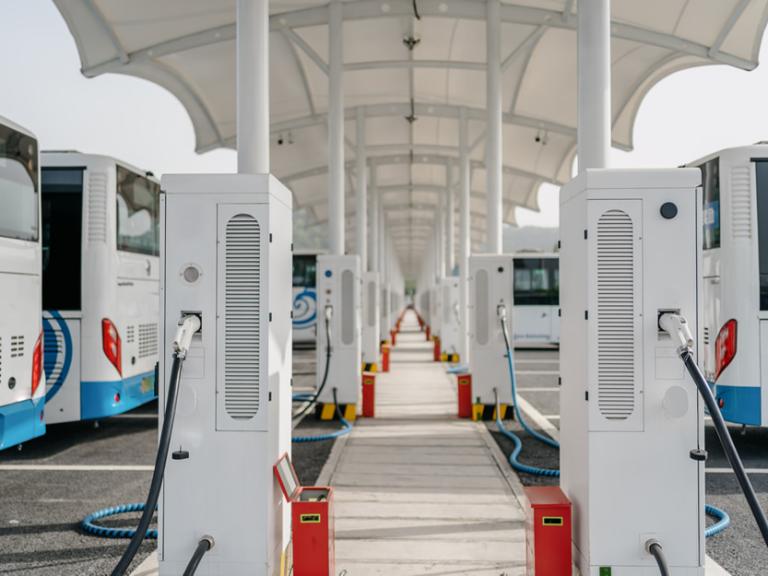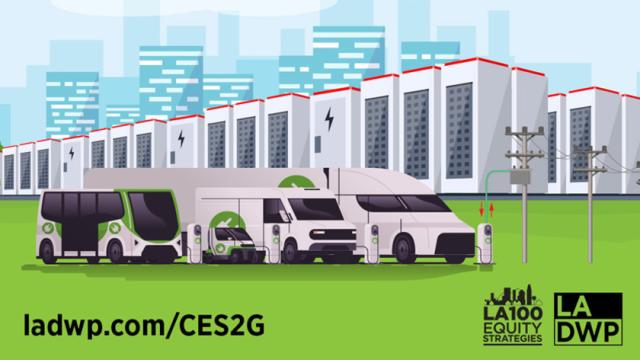To help electrify large fleets while supporting grid resiliency and reliability, LADWP launched the Nation’s first municipal Commercial Energy Storage to Grid (CES2G) Pilot Program in June 2023.
The new, landmark vehicle-to-grid (V2G) and energy storage-to-grid program provides customers with reimbursement for interconnection costs, and payments for sending stored electricity to LADWP’s electric grid during critical peak periods (CPP).
Eligible participants may include commercial, industrial and institutional customers using high-voltage DC fast chargers for large fleets of electric buses, trucks or other types of EVs, as well as stationary batteries.
“This can provide a great benefit to customers by generating revenue, reducing investment and operating costs, while helping achieve LADWP’s goals of in basin generation, emission reductions, and improved grid reliability,” said Arash Saidi, LADWP's Manager of Distributed Resource Development and Programs.
The CES2G Program supports one of Mayor Karen Bass’ three goals for building a “Greener Los Angeles” by expanding electrification of LA’s transportation system. Mayor Bass’ goals, which were announced following Climate Week NYC held at the end of September also include decarbonizing power generation and reducing greenhouse gas emissions from commercial and residential buildings.

To help with infrastructure costs, the CES2G Program can provide qualifying customers with up to 75% of the Interconnection Costs as a one-time lump sum payment of up to $150,000 on the 4.8-kV system and $400,000 on the high voltage 34.5-kV system.
The other financial benefit is the energy purchase rate. The Distribution Voltage Energy Storage Supply Service (DESS) Rate Agreement guarantees 17 cents per kWh above the peak rate paid for all discharged energy for a minimum of 50 critical peak period (CPP) events annually.
In the event LADWP conducts fewer events than the 50-event minimum, a customer will receive a total payment of unconducted Critical Peak Period (CPP) events as shown in the example below.
Below is a fictional example of a facility participating in the CES2G Program:
• LADWP only conducts 20 Critical Peak Period discharge events in year one. All CPP discharge events occur in the first three contract quarters (Q1-Q3)
• Facility Energy Storage Capacity: 1,200 kW-hr
• Average energy discharged during the 20 Critical Peak Periods over the first three quarters: 400 kWh
• Customer is under a DESS 2 Rate
| Description | Value |
|---|---|
| Energy Storage Capacity | 1,200 kWh |
| Average energy discharged during 20 CPP events (Q1-Q3) | 400 kWh |
| DESS 2 Rate | $0.39786 per kWh |
| Number of CPP events conducted in year one | 20 |
| Number of unconducted CPP events | 30 (50 - 20) | |
|---|---|---|
| Payment for the first 20 CPP discharge events | 20×400×0.3978620×400×0.39786 | $3,182.88 |
| Payment for the remaining 30 unconducted CPP events | 30×400×0.3978630×400×0.39786 | $4,774.32 |
| Total Payment for the First Contract Year | $7,957.20 |
The total amount paid over the first contract year, including to make up for not conducting 50 Critical Peak Period events, is $7,957.20.
To qualify, battery energy storage systems (BESSs) must utilize lithium-ion batteries or similar technology subject to LADWP’s discretion. Facilities are limited to a Capacity of 300 kW-AC on the 4.8-kV system or 3 MW-AC on the 34.5-kV system and must be interconnected to the LADWP system at one single interconnection point. Lastly, mobile or stationary energy storage systems, including electric vehicle fleets, would require a separate meter and charging equipment that is bi-directional and capable of both charging and discharging power.
Developed in part to address the City and State’s energy and decarbonization goals, the CES2G Program is expected to reduce carbon emissions by approximately 5,000 metric tons. In addition, the program supports improved reliability and operational flexibility for the distributed energy resources (DER) that will come from customers’ stationary and mobile storage via dynamic, bi-directional technology dispatched by LADWP’s Energy Control Center.
To further support adoption and expansion of EV fleets and their infrastructure, the financial benefit from qualifying projects can be paired with Federal incentives under the Inflation Reduction Act, as well as other state and local grants.
Customers interested in this program are encouraged to act fast as funding for this pilot program is limited.
For more information, please contact your account advisor.
November 2023 Connections Newsletter
From industry trends and best practices to sustainability initiatives, our monthly Connections Newsletter provides valuable insights, updates, and resources to support our large business customers.
Full Newsletter